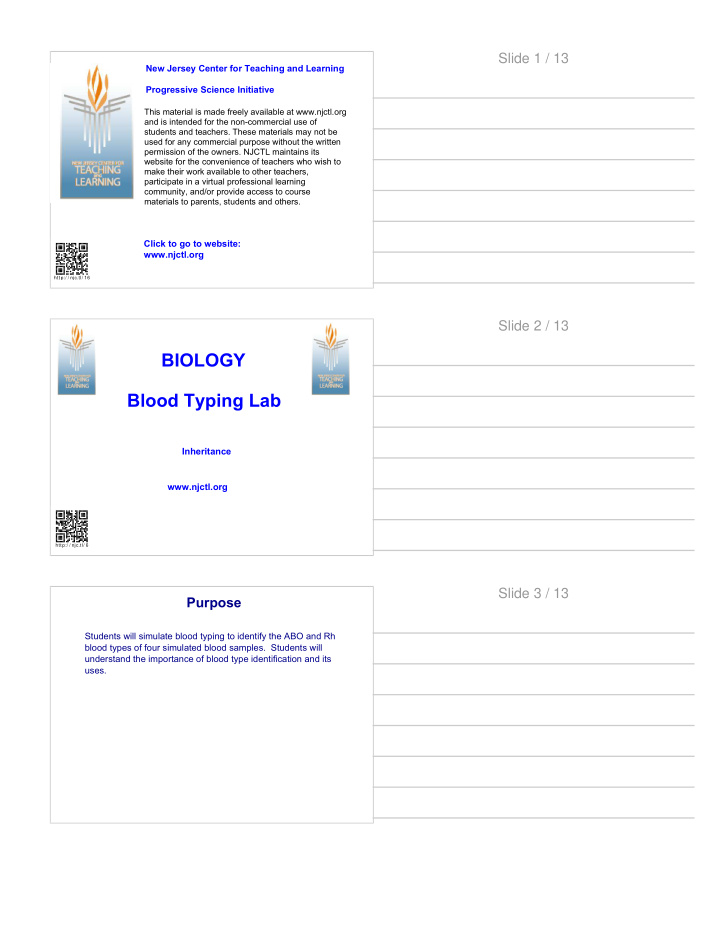



Slide 1 / 13 New Jersey Center for Teaching and Learning Progressive Science Initiative This material is made freely available at www.njctl.org and is intended for the non-commercial use of students and teachers. These materials may not be used for any commercial purpose without the written permission of the owners. NJCTL maintains its website for the convenience of teachers who wish to make their work available to other teachers, participate in a virtual professional learning community, and/or provide access to course materials to parents, students and others. Click to go to website: www.njctl.org http:/ / njc.tl/ 16 Slide 2 / 13 BIOLOGY Blood Typing Lab Inheritance www.njctl.org http:/ / njc.tl/ 6 Slide 3 / 13 Purpose Students will simulate blood typing to identify the ABO and Rh blood types of four simulated blood samples. Students will understand the importance of blood type identification and its uses.
Slide 4 / 13 Materials Blood typing slides Four unknown simulated blood vials Vials of anti-A, anti-B, and anti-Rh sera Blue, yellow, and white mixing sticks or toothpicks Slide 5 / 13 Procedure Step 1 Obtain one vial of synthetic blood and place a drop in each well of the blood typing slide. Replace the cap on the blood vial. Make sure not to touch the tip of the vial to any surface to avoid contaminating the sample. Step 2 Add one drop of synthetic anti-A serum to the well labelled “A”. Replace the cap on the vial. Avoid touching the synthetic blood or any other surface with the tip of the anti-serum vial. Doing so will contaminate your serum and this will affect not only your results but it will affect everyone else’s results as well. Step 3 Add one drop of synthetic anti-B serum to the well labelled “B”. Replace the cap on the vial. Follow the same precautions as in #2. Step 4 Add one drop of synthetic anti-Rh serum to the well labelled Rh. Replace the cap on the vial. Follow the same precautions as in #2. Slide 6 / 13 Procedure Step 5 Using different colored mixing sticks for each well, gently stir the contents in each well (one at a time) for 30 seconds. DO NOT USE THE SAME STICK TO MIX MORE THAN ONE WELL. Doing so will contaminate your results. Discard the mixing sticks in the trash once you are done. Step 6 Examine the contents in each well. If the liquid remains unchanged, no agglutination has taken place (- result). If the contents appear granular, agglutination has occurred (+ result). Determine the blood type of the blood sample and record your results in Table 1. A positive agglutination reaction indicates the blood type. Step 7 Rinse the blood typing tray and dry it. Repeat steps 1-6 for the three other sample of blood by testing each one one at a time. Make sure to record data in the correct column if you are not testing the blood samples in order.
Slide 7 / 13 Data Sample 1 Sample 2 Sample 3 Sample 4 Anti-A Anti-B Rh Blood Type Slide 8 / 13 Blood Typing Lab Analysis Grade: «grade» Subject: «subject» Date: «date» Slide 9 / 13 1 For each of the given blood types, indicate the expected agglutination results when blood is mixed with each antibody: Students type their answers here Blood Type Anti-A Anti-B Anti-Rh A+ A- B+ B- AB+ AB- O+ O-
Slide 10 / 13 2 A store is broken into in the middle of the night and the safe is stolen. The thief apparently cut him/herself on a piece of broken glass. You are a CSI and forensic expert called to the scene of the Students type their answers here crime. You test a sample of the thief’s blood and find it to be O-. In the meantime, the police arrest a suspect not too far from the crime scene. The suspect has a cut on his hand. You obtain a sample of the suspect’s blood and test it. You add anti-A serum to the blood and you immediately know that the suspect is not the person whose blood was found at the crime scene. How do you know this? Slide 11 / 13 3 Suppose when you test the suspects blood, that it does not agglutinate when tested with anti-A or anti-B but it does when tested Students type their answers here with anti-Rh. Would this connect this suspect to the blood found at the crime scene? Explain your answer. Slide 12 / 13 4 Two brothers have type O+ and type O- blood respectively. Their sister has AB+ blood. Assuming they have the same parents, what are the possible genotypes their parents? Students type their answers here
Slide 13 / 13 5 Why is O- blood considered the "universal donor"? Students type their answers here
Recommend
More recommend